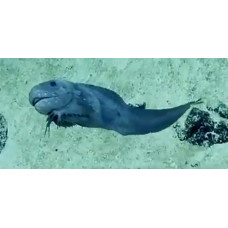Latin name
Careproctus latiosus
Identification
The broad-mouth tadpole can be identified by the following characteristics:
59-60 vertebrae
Two pairs of weak pleural ribs
Three to four rounded thoracic radii
A body that is 4.6-4.9 times as deep as the standard length
A head that is 26-27% of the body length
A broad snout
An occipital pore and one supraorbital pore
Small eyes
A large mouth with the corner of the mouth below the center of the eye
Simple teeth
A nose that is 36-40% of the body length
A disc that is 6.3-6.6% of the body length
Features of fish fins
Dorsal soft rays (total): 52. The lower pectoral fin blade is shorter than the upper one.
Fish colouring
The Broad-mouth tadpole has a pale body and a black peritoneum.
Distribution
It is widespread in the Arctic Ocean: Norwegian Sea.
Habitat
This marine bathydemersal species inhabits depths ranging from 1,478 to 1,695 meters.
Size
Females of this species reach a maximum length of 9.8 cm.
Behavior
These fish travel by attaching themselves to the legs or backs of crabs.
Food and feeding habits
The broad-mouth tadpole feeds on small animals.
Reproduction
This fish species' reproductive biology has not yet been studied.
Fishing
This species is not commercially important.
Relationship with a person
Harmless.
| Classification | |
| Phylum | Chordata |
| Class | Actinopterygii |
| Squad | Perciformes |
| Family | Liparidae |
| Genus | Careproctus |
| Species | C. latiosus |
| Features | |
| Conservation status | Not Evaluated |
| Habitat | Bottom |
| Life span, years | No information |
| Maximum body weight, kg | No information |
| Maximum length, cm | 9,8 |
| Sailing speed, m/s | No information |
| Threat to people | Edible |
| Way of eating | Planktonophage |
Broad-mouth tadpole
Tags: broad mouth tadpole


